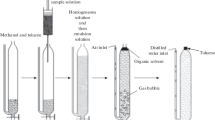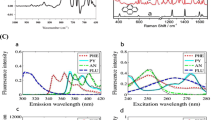Abstract
The use of 2-hydroxypropyl-β-cyclodextrin (2-HPCD) for the tandem extraction and proximity-induced energy transfer based detection of carcinogenic polycyclic aromatic hydrocarbons (PAHs) is described herein. Previous work investigated γ-cyclodextrin for this purpose, but the lower cost and reduced toxicity of 2-HPCD made it an attractive target for investigation. 2-HPCD was found to be highly efficient in the extraction of PAHs from oil samples, but was equally or slightly less efficient in promoting intra-cavity energy transfer to a high quantum yield fluorophore. The detection of PAHs via this system results in a new fluorescent signal that can be used to identify different PAHs in aqueous solution. This dual-function system can be very beneficial for oil spill remediation efforts.




Similar content being viewed by others
References
McNutt, M.K., Chu, S., Lubchenco, J., Hunter, T., Dreyfus, G., Murawski, S.A., Kennedy, D.M.: Applications of science and engineering to quantify and control the Deepwater Horizon oil spill. Proc. Natl. Acad. Sci. USA 109, 20222–20228 (2012)
http://www.foxnews.com/us/2013/10/15/oil-unwelcome-discovery-for-north-dakota-farmer/
http://www.texastribune.org/2014/04/04/shorebirds-devastated-galveston-oil-spill/
Onwurah, I.N.E., Ogugua, V.N., Onyike, N.B., Ochonogor, A.E., Otitoju, O.F.: Crude oil spills in the environment, effects and some innovative clean-up biotechnologies. Int. J. Environ. Res. 1, 307–320 (2007)
Manzetti, S.: Ecotoxicity of polycyclic aromatic hydrocarbons, aromatic amines, and nitroarenes through molecular properties. Environ. Chem. Lett. 10, 349–361 (2012)
Silliman, B.R., van de Koppel, J., McCoy, M.W., Diller, J., Kasozi, G.N., Earl, K., Adams, P.N., Zimmerman, A.R.: Degradation and resilience in Louisiana salt marshes after the BP-Deepwater Horizon oil spill. Proc. Natl. Acad. Sci. USA 109, 11234–11239 (2012)
Incardona, J.P., Collier, T.K., Scholz, N.L.: Oil spills and fish health: exposing the heart of the matter. J. Expo. Sci. Environ. Epidemiol. 21, 3–4 (2011)
Page, D.S., Chapman, P.M., Landrum, P.F., Neff, J., Elston, R.: A perspective on the toxicity of low concentrations of petroleum-derived polycyclic aromatic hydrocarbons to early life stages of herring and salmon. Hum. Ecol. Risk Assess. 18, 229–260 (2012)
Perez-Cadahia, B., Mendez, J., Pasaro, E., Lafuente, A., Cabaleiro, T., Laffon, B.: Biomonitoring of human exposure to Prestige oil: effects on DNA and endocrine parameters. Environ. Health Insights 2, 83–92 (2008)
Verma, N., Pink, M., Rettenmeier, A.W., Schmitz-Spanke, S.: Review on proteomic analyses of benzo[a]pyrene toxicity. Proteomics 12, 1731–1755 (2012)
Srogi, K.: Monitoring of environmental exposure to polycyclic aromatic hydrocarbons: a review. Environ. Chem. Lett. 5, 169–195 (2007)
Schaum, J., Cohen, M., Perry, S., Artz, R., Draxler, R., Frithsen, J.B., Heist, D., Lorber, M., Phillips, L.: Screening level assessment of risks due to dioxin emissions from burning oil from the BP Deepwater Horizon Gulf of Mexico spill. Environ. Sci. Technol. 44, 9383–9389 (2010)
He, C., Zuo, Z., Shi, X., Sun, L., Wang, C.: Pyrene exposure influences the thyroid development of Sebastiscus marmoratus embryos. Aquat. Toxicol. 124–125, 28–33 (2012)
Khobragade, V., Kulkarni, S.D.: Microbial remediation of polycyclic aromatic hydrocarbons: an overview. Res. J. Chem. Environ. 16, 200–212 (2012)
Lin, J.-H., Tseng, W.-L.: Gold nanoparticles for specific extraction and enrichment of biomolecules and environmental pollutants. Rev. Anal. Chem. 31, 153–162 (2012)
Rubio-Clemente, A., Torres-Palma, R.A., Penuela, G.A.: Removal of polycyclic aromatic hydrocarbons in aqueous environment by chemical treatments: a review. Sci. Total Environ. 478, 201–225 (2014)
Plaza-Bolanos, P., Frenich, A.G., Vidal, J.L.M.: Polycyclic aromatic hydrocarbons in food and beverages. Analytical methods and trends. J. Chromatogr. A 1217, 6303–6326 (2010)
Serio, N., Chanthalyma, C., Prignano, L., Levine, M.: Cyclodextrin-enhanced extraction and energy transfer of carcinogens in complex oil environments. ACS Appl. Mater. Interfaces 5, 11951–11957 (2013)
Mako, T., Marks, P., Cook, N., Levine, M.: Fluorescent detection of polycyclic aromatic hydrocarbons in ternary cyclodextrin complexes. Supramol. Chem. 24, 743–747 (2012)
Serio, N., Miller, K., Levine, M.: Efficient detection of polycyclic aromatic hydrocarbons and polychlorinated biphenyls via three-component energy transfer. Chem. Commun. 49, 4821–4823 (2013)
Serio, N., Chanthalyma, C., Prignano, L., Levine, M.: Cyclodextrin-promoted energy transfer for broadly applicable small-molecule detection. Supramol. Chem. (2014). doi:10.1080/10610278.2013.860226
Serio, N., Prignano, L., Peters, S., Levine, M.: Detection of medium-sized polycyclic aromatic hydrocarbons via fluorescence energy transfer. Polycycl. Aromat. Compd. 34, 561–572 (2014)
Uekama, K., Hirayama, F., Irie, T.: Cyclodextrin drug carrier systems. Chem. Rev. 98, 2045–2076 (1998)
Gould, S., Scott, R.C.: 2- Hydroxypropyl-β-cyclodextrin (HP-β-CD): a toxicology review. Food Chem. Toxicol. 43, 1451–1459 (2005)
Huang, H., Tang, G., Wang, Q., Li, D., Shen, F., Zhou, J., Yu, H.: Two novel non-viral gene delivery vectors: low molecular weight polyethylenimine cross-linked by (2-hydroxypropyl)-β-cyclodextrin or (2-hydroxypropyl)-γ-cyclodextrin. Chem. Commun. 22, 2382–2384 (2006)
Casulli, A., Gomez Morales, M.A., Gallinella, B., Turchetto, L., Pozio, E.: 2-Hydroxypropyl-β-cyclodextrin improves the effectiveness of albendazole against encapsulated larvae of Trichinella spiralis in a murine model. J. Antimicrob. Chemother. 58, 886–890 (2006)
Oddy, F.E., Brovelli, S., Stone, M.T., Klotz, E.J.F., Cacialli, F., Anderson, H.L.: Influence of cyclodextrin size on fluorescence quenching in conjugated polyrotaxanes by methyl viologen in aqueous solution. J. Mater. Chem. 19, 2846–2852 (2009)
Shepherd, J.L., Kell, A., Chung, E., Sinclar, C.W., Workentin, M.S., Bizzotto, D.: Selective reductive desorption of a SAM-coated gold electrode revealed using fluorescence microscopy. J. Am. Chem. Soc. 126, 8329–8335 (2004)
Hood, D.B., Ramesh, A., Chirwa, S., Khoshbouei, H., Archibong, A.E.: Developmental toxicity of polycyclic aromatic hydrocarbons. In: Gupta, R.C. (ed.) Reproductive and Developmental Toxicology, pp. 593–606. Academic Press, London (2011)
Hecht, S.S.: Smoking and lung cancer- a new role for an old toxicant? Proc. Natl. Acad. Sci. USA 103, 15725–15726 (2006)
Hamai, S.: Complex formation of tetrakis(4- sulfonatophenyl) porphyrin with γ-cyclodextrin, phenylalanine, and tryptophan in aqueous solution. J. Incl. Phenom. Macrocycl. Chem. 67, 471–481 (2010)
Basilio, N., Francisco, V., Garcia-Rio, L.: Independent pathway formation of guest-host in host ternary complexes made of ammonium salt, calixarene, and cyclodextrin. J. Org. Chem. 77, 10764–10772 (2012)
Czaban, A.: The influence of temperature and shear rate on the viscosity of selected motor oils. Solid State Phenom. 199, 188–193 (2013)
Gunstone, F.D.: Composition and properties of edible oils. In: Hamm, W., Hamilton, R.J., Calliauw, G. (eds.) Edible Oil Processing, 2nd edn, pp. 1–39. Wiley, Hoboken (2013)
Lu, S.-T., Kaplan, I.R.: Characterization of motor lubricating oils and their oil-water partition. Environ. Forensics 9, 295–309 (2008)
Drabova, L., Tomaniova, M., Kalachova, K., Kocourek, V., Hajslova, J., Pulkrabova, J.: Application of solid phase extraction and two-dimensional gas chromatography coupled with time-of-flight mass spectrometry for fast analysis of polycyclic aromatic hydrocarbons in vegetable oils. Food Control 33, 489–497 (2013)
Creighton, M.A., Ohata, Y., Miyawaki, J., Bose, A., Hurt, R.H.: Two-dimensional materials as emulsion stabilizers: interfacial thermodynamics and molecular barrier properties. Langmuir 30, 3687–3696 (2014)
McClements, D.J.: Advances in fabrication of emulsions with enhanced functionality using structural design principles. Curr. Opin. Colloid Interface Sci. 17, 235–245 (2012)
Acknowledgments
Funding is acknowledged from the Gulf of Mexico Research Initiative.
Conflict of interest
The authors declare no conflict of interest.
Author information
Authors and Affiliations
Corresponding author
Electronic supplementary material
Below is the link to the electronic supplementary material.
Rights and permissions
About this article
Cite this article
Serio, N., Chanthalyma, C., Peters, S. et al. 2-Hydroxypropyl beta-cyclodextrin for the enhanced performance of dual function extraction and detection systems in complex oil environments. J Incl Phenom Macrocycl Chem 81, 341–346 (2015). https://doi.org/10.1007/s10847-014-0460-0
Received:
Accepted:
Published:
Issue Date:
DOI: https://doi.org/10.1007/s10847-014-0460-0




